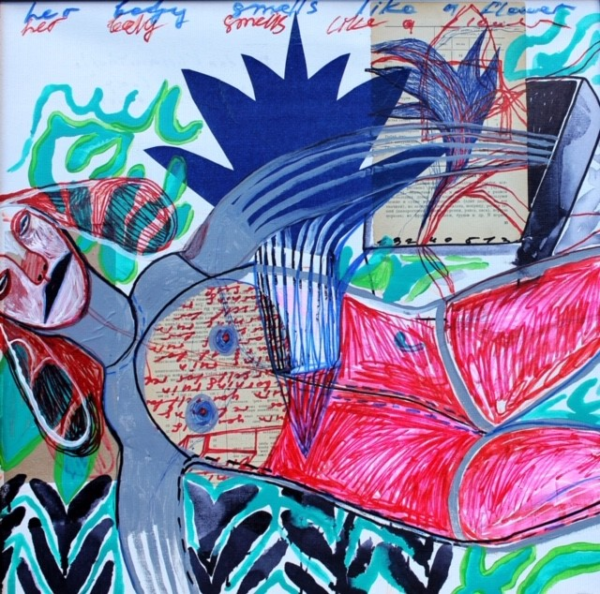
Rusudan Khizanishvili, Her Super Body, 2019, Acrylic on canvas, 19.68 x 19.68 inches, courtesy of the artist.
New York Meets Tbilisi: Defining Otherness – Part I
Curated by Nina Mdivani and presented by Kunstraum LLC
Featuring Rusudan Khizanishvili and Juliana Cerqueira Leite
January 17 – February 23, 2020
Opening Friday, January 17, 6-8 pm
Assembly Room and Kunstraum LLC are pleased to present New York Meets Tbilisi: Defining Otherness-Part I, a group exhibition curated by Nina Mdivani, featuring works by Rusudan Khizanishvili and Juliana Cerqueira Leite, as part of the curator’s investigation into the contemporary Georgian art in dialogue with New York-based artists.
The first part held at Assembly Room, focuses on works of Tbilisi-based painter Rusudan Khizanishvili (Tbilisi, 1979) and New York-based sculptor Juliana Cerqueira Leite (Sao Paulo,1981), while the second part of this exhibition features 12 Georgian and American artists and will be held at Kunstraum LLC, both shows culminate Mdivani’s year-long curatorial residency at Kunstraum.
The main question this exhibition poses is how the phenomenon of Otherness is defined when examined in relation to two different cultures and understandings of the world, as well as considers onlookers’ reactions when experiencing Otherness in the form of a person different from their own race, orientation, or background. Another subtler dimension of this important fundamental question is how Otherness is encountered within one’s own persona, whether it be in the form of prejudice or shared historical and collective memory.
As Georgia has been undergoing significant transformation within the last thirty years, the country has to recognize its Soviet past, along with the mechanisms that have helped it to survive for centuries. Georgian art has mirrored this journey, at times reverting to mimicry through a Soviet or Western visual language, and at other times by producing strongly authentic work. Similarly, Otherness is experienced at many different levels in the United States that have led in the past to racial violence as well as to intra-cultural consensus.
The two artists presented in this exhibition work on the same theme of Otherness while producing two different and strong reactions, either of fear and hence a desire to dominate or of infatuation and hence a desire to own. As two women examine this theme through the mediums of painting and sculpture, they share an understanding that both of these impulses are strongly influenced by overarching patriarchal structures based on the philosophies of Darwin and perpetuated in colonial discourse.
Khizanishvili uses her exceptional palette and vibration of primal colors to examine the dissonance present in contemporary society. Her canvases are populated by mysterious beings that lack ethnic Georgian attributes and resonate with more universal, archetypal meanings. One finds bodies of ancient goddesses and schematically portrayed stones melting under the heaviness of human histories. By assembling these fragments and then breaking them apart to be later reassembled into new fantastical beings, Khizanishvili mirrors the globally present feeling of ambiguity, fluidity, and distortion even more valid for her native country. In order for a woman to seize the identity of the Other in relation to the wider world, we women and representatives of ‘alien’ cultures, need to become like the structure that holds the power.
Cerqueira Leite’s evocative clay objects function as evolutionary permutations or collection of sensory organs. By abstracting and manipulating separate parts of a head, her objects become representative of a category, rather than of a person, through the artist’s intentional failure to convey subjectivity. By creating new species, Leite’s works speak directly to Khizanishvili’s metaphors, referencing the transition from the Other to the Undesirable. Both artists’ works need to go through a transformation in order to become acceptable, more understandable, more conforming; yet Cerqueira Leite intentionally allows them to exist as ‘failed heads.’ In her work, she sees Otherness as a concept tied to the female body and dominant narratives of the Western world. By expressing otherness as bodily porosity, instability, and hybridity, she achieves a distorted reiteration of global society.
This exhibition brings together two distinct artists who come from the same generation and frame of mind while residing in two different parts of the world. Yet, they both investigate the failure of communication and desire, of meaning- making projections in the context of patriarchal and Western-oriented values. The visual language of art, as demonstrated by their respective practices, could and should empower us.
This collaboration between Assembly Room and Kunstraum LLC serves each’s mutual mission of highlighting independent curators and thought-provoking exhibition concepts aiming to engage with the larger cultural discourse.
Juliana Cerqueira Leite (1981) is a Brazilian sculptor based in New York and São Paulo. She is represented in London, England by T.J. Boulting, in São Paulo, Brazil by Casa Triângulo, and in Venice, Italy by Alma Zevi.
Her sculpture Climb, 2012 is currently on exhibit at Mitre Square in Central London as part City of London’s Sculpture in the City initiative. She is currently preparing for solo exhibitions opening January 9th, 2020 at Alma Zevi gallery in Venice, Italy, and then February 1st, at Casa Triângulo gallery in São Paulo, Brazil.
Cerqueira Leite received the 2019 Pollock-Krasner Foundation Grant for her exhibition Orogenesis at the National Archaeological Museum in Naples, Italy. She was awarded the 2016 Furla Art Prize for her contribution to the 5th Moscow Young Art Biennale. She has exhibited her work internationally in solo and group shows in venues including institutions such as Instituto Tomie Ohtake in São Paulo, Hordaland Kunstsenter in Bergen, The Sculpture Center in New York, and Marres House for Contemporary Culture in Maastricht. She has also exhibited in galleries such as the Saatchi Gallery in London, Galeria Casa Triângulo in São Paulo, Alma Zevi in Venice, Galleria Lorcan O’Neill in Rome, TJ Boulting in London, DUVE in Berlin, Arsenal Contemporary and Regina Rex Gallery in New York. She has exhibited in Biennales and Triennales including The Antarctic Pavilion in the 2017 Venice Biennale, Bergen Assembly 2019, Moscow Young Art Biennale, Marrakech Biennale and was one of eight artists chosen to represent Brazil in the 2014 Vancouver Sculpture Biennial. Cerqueira Leite graduated from the Slade School of Fine Art (UCL) Graduate Sculpture program in London in 2006 as recipient of the Kenneth Armitage Sculpture Prize.
Rusudan Khizanishvili (1979) lives and paints in Tbilisi, Georgia. She has received her two BFAs in Painting from J.Nikoladze Art School and from Tbilisi State Academy of Art. In 2004 Rusudan received her MA in Film Studies from Tbilisi State Academy of Art. In 2015 ten of her works have been bought by the Georgian National Museum of History and Culture as part of the Georgian national heritage. The same year Khizanishvili represented Georgia among five other artists at the 56th Venice Art Biennale. In 2017 Khizanishvili had solo exhibition at Mark Rothko Foundation in Daugavapils, Latvia. In the last decade Khizanishvili has participated in numerous group and solo exhibitions in Georgia and Europe including Museum of Literature of Georgia, Tbilisi State Silk Museum, Racha Regional Museum, Oni, Georgia, Museum of Fine Art in Nalchik, Russia, Kunstrverein at Villa Wessel Iserlohn, Germany, Galerie Am Roten Hof in Vienna, Austria, Arundel Contemporary in Arundel as well as at New Image Art Gallery, Santa Monica, USA


